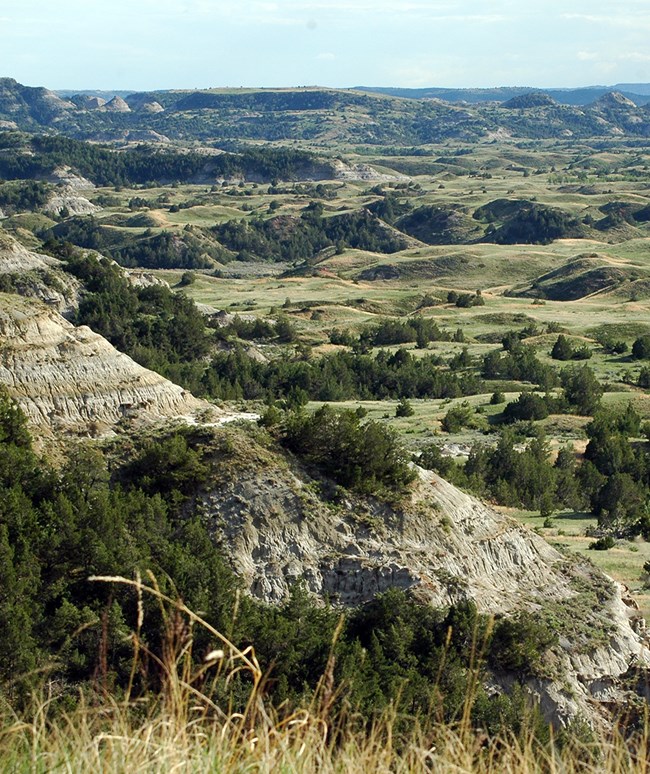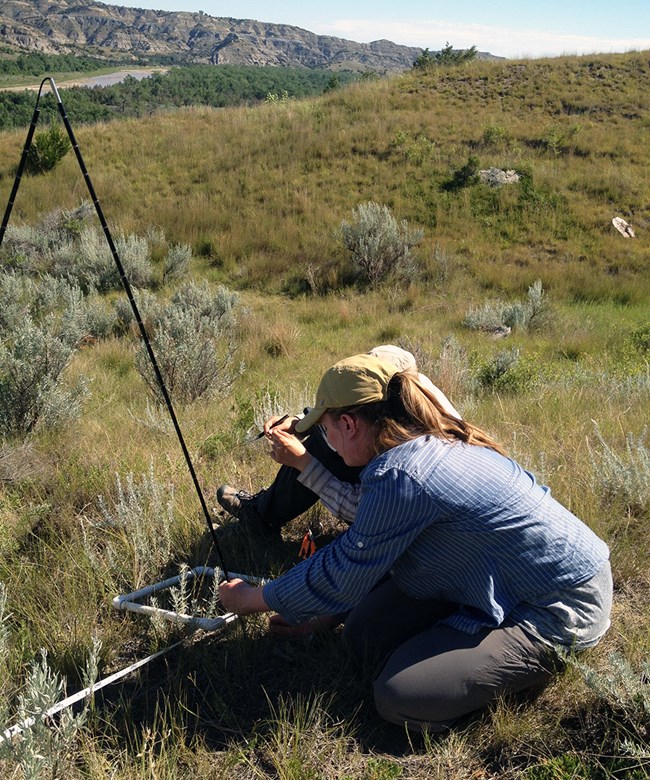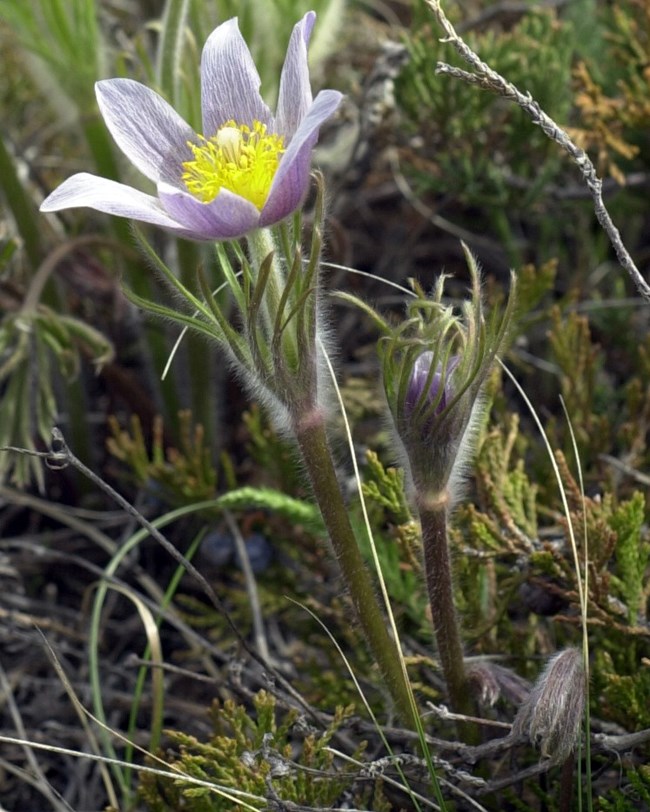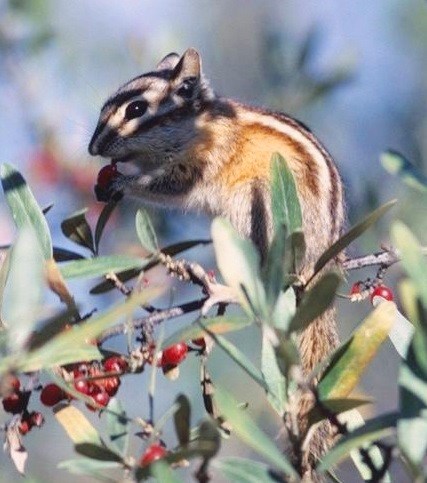Part of a series of articles titled Plant Community Monitoring in Northern Great Plains Network Parks.
Article
Plant Community Monitoring at Theodore Roosevelt National Park

NPS
Overview
Within North Dakota, more than 71% of the mixed-grass prairie has been lost since European Settlement. Theodore Roosevelt National Park in southwestern North Dakota encompasses 70,477 acres in the Little Missouri River Badlands. The park is made up of three separate units (North Unit, South Unit, and Elkhorn Ranch Site) connected by the Little Missouri River. Each unit protects a patchwork of mixed-grass prairie, clay buttes, bottomland forest, and open shrublands.
Plants on the park are sensitive to many stressors including invasive exotic species, habitat fragmentation, climate change, and altered fire and grazing patterns. Park management actions, such as prescribed fire, exotic species control, and wildlife management, may also affect plant communities. The Northern Great Plains Inventory and Monitoring Network conducts long-term monitoring of plant communities at Theodore Roosevelt National Park because it helps us better understand the current health of ecosystems and it can provide an early warning of undesirable changes.

NPS/Ryan Manuel

NPS
What We Monitor
The Northern Great Plains Network established plant monitoring plots in 2010 throughout the North and South units of the park in grasslands, juniper forests, badlands, cottonwood forests, and shrublands. A subset of these plots is monitored each year on a rotating basis. At each plot, we record the native and exotic plant species found and the vegetation cover of each species, a measure of how much ground is covered by the plants. When woody species are present, tree regeneration and tall shrub density data are collected. The NPS Northern Great Plains Fire Ecology Program started monitoring plants in the late 1990s, but our collaboration with the Fire Ecology Program and use of current methods began in 2010.
In 2015, we surveyed plots in the riparian (riverside) forests along the Little Missouri River to better understand the status and trends in river valley vegetation specifically. We collect information on tree stem density, tree diameter, tree status (live or dead) and condition (leaf-discoloration, insect-damaged, etc.), cover of exotic species, and disturbance. We plan to survey these riparian plots every five years.

NPS
Plant Communities in the Park
The Theodore Roosevelt National Park plant list includes 554 species. In 2018, 223 unique plant species were found on monitoring plots and 34 of these were exotic species. Over 360 species have been found in monitoring plots since 2010. Graminoids (grasses, sedges, and rushes) accounted for most of the vegetation cover, but forbs (flowering plants that are not woody and not a grass or grass-like), vines, trees, shrubs, and sub-shrubs (low-growing shrubs) are also present. Four rare plant species were discovered on plots.
Exotic species were common in all areas of the park. The average exotic species cover is 24%, which is more than twice the management target of 10%. Kentucky bluegrass (Poa pratensis) and smooth brome (Bromus inermis) make up most of the exotic species cover on the park, but other common exotics include leafy spurge (Euphorbia esula), Canada thistle (Cirsium arvense), and yellow sweetclover (Melilotus officinalis).
Riparian vegetation communities in the park are diverse, and include mature cottonwood forests, sagebrush shrublands, and dense willow communities. Riparian forests are primarily composed of plains cottonwood (Populus deltoides), Rocky Mountain juniper (Juniperus scopulorum), and green ash (Fraxinus pennsylvanica) trees. The South Unit has fewer plains cottonwood trees and they are less dense. It also has six times the density of dead cottonwood snags, suggesting there has been a recent general decline of cottonwood forest condition in this unit of the park.
More Details
- The average number of native species per square meter (about 9/m2) is within the range found in native prairie in the region, indicating that the park upland vegetation is in good condition.
- Western wheatgrass (Pascopyrum smithii), western snowberry (Symphoricarpos occidentalis), and the exotic grass Kentucky bluegrass (Poa pratensis) were the most common species in the park.
- Native plant diversity and cover are considerably higher and exotic species cover is lower in the uplands compared to the riparian areas.
- There has been a significant increase in exotic species cover in the riparian areas since 2010. While this trend was not seen in uplands plots, Kentucky bluegrass is significantly increasing in all areas of the park.
- The North Unit has more cottonwood forest, a more diverse tree assemblage, and lower exotic species cover in the understory than the South Unit.

NPS
Did You Know?
Plant communities that grow along the banks or rivers and streams are known as riparian communities. These habitats are extremely important as they provide food and shelter for a wide range of both aquatic and land animals and have a high level of species diversity. Healthy riparian habitats also have a vital role in soil conservation and erosion control. At Theodore Roosevelt National Park, we collect data from plots in riparian areas to inform park managers of the condition of this vital habitat, and track the spread of exotic and invasive species.
For More Information
Visit the Northern Great Plains Network website to read more about plant monitoring at Theodore Roosevelt National Park.
Protocol Contact, Northern Great Plains Inventory and Monitoring Network: Isabel Ashton
Summary by Northern Great Plains Network, updated in 2019
Last updated: November 20, 2019
